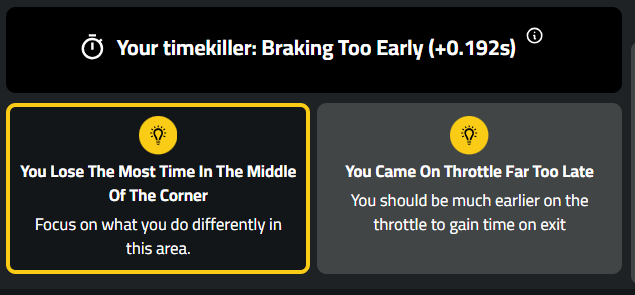Ford FG Falcon Silverstone Park Hot Lap Analysis
Let’s delve into the telemetry from a hot lap around Silverstone in the V8 Supercars Ford FG Falcon driven by HYMO.
Analysis

Charlie from the Hymo team demonstrates superior cornering techniques that contribute to faster lap times. At the start of a corner, Charlie carries more speed from the previous turn, allowing for a dynamic entry and preserved momentum. He also achieves a higher minimum speed earlier in the corner than his competitor, enabling him to accelerate sooner and regain high speeds quickly. This results in less time lost during corner exit.
In terms of braking, Charlie applies peak brake pressure rapidly and decisively, shortening the braking phase and maintaining higher entry speeds into corners. This contrasts with the other driver's gradual approach to peak brake pressure, which is less efficient and results in longer deceleration times. To improve performance, drivers should aim to replicate Charlie's assertive braking style.
Charlie's throttle control is smooth and progressive, maximising traction and maintaining higher speeds through corners. The other driver's erratic throttle application leads to loss of grip and slower exit speeds. It is recommended that drivers focus on steady throttle increases and avoid over-lowering gears around the apex to maintain momentum.
Overall, emulating Charlie's technique; carrying more speed into corners, achieving higher minimum speeds earlier, assertive braking, and smooth throttle control can lead to significant improvements in lap times. These methods reflect an efficient driving style characteristic of an e-sports professional like Charlie from the Hymo team.

Analyzing the speed chart, it is evident that Charlie from the Hymo team maintains a higher speed at the very start of the corner compared to the other driver. This indicates that Charlie has carried more speed from the exit of the previous corner, which provides a crucial advantage as he approaches the current turn. The initial higher speed allows for a more dynamic entry into the corner, setting up for an overall faster lap time due to preserved momentum. Further into the corner, we observe that Charlie's minimum speed is achieved earlier and is higher than that of the other driver. This is critical as it shows Charlie's ability to manage his vehicle's momentum and grip effectively, allowing him to get back on throttle sooner. The consequence of this earlier acceleration is demonstrated by a steeper gradient in Charlie's speed chart compared to his competitor post-minimum speed point, indicating a quicker return to high speeds. This results in less time lost during corner exit and contributes significantly to lap time improvement. Therefore, maintaining a higher minimum speed and achieving it earlier in the corner should be a focus for drivers looking to improve their performance on track.

Charlie's braking application demonstrates a superior technique that contributes to his impressive lap times. His rapid and decisive input to reach peak brake pressure allows for a shorter braking phase, enabling him to maintain higher speeds into the corners. This technique is particularly effective in high-performance vehicles where the brakes are designed to handle such forceful engagement without upsetting the car's balance. The other driver's more gradual approach to peak brake pressure suggests a less efficient use of the braking system, resulting in longer distances and times spent decelerating. To improve lap times, this driver should focus on emulating Charlie's assertive braking style, which capitalizes on the vehicle's capabilities and maximizes speed carried through each corner. This adjustment would likely yield significant improvements in overall performance on track.

Charlie's throttle control is consistently smoother and more progressive than the other driver, as indicated by the cyan line on the chart. This precise application of throttle means Charlie is maximizing traction and maintaining higher speeds through corners, which contributes to faster lap times. The other driver's throttle application is more erratic, with sharper spikes and drops, indicating a less smooth acceleration pattern that can lead to loss of grip and slower corner exit speeds. To improve lap times, it's crucial to emulate Charlie's approach by focusing on smooth and steady throttle increases. Avoiding over-lowering gears around the apex will maintain momentum and prevent engine bogging, which can be observed in Charlie's performance. This technique allows for better speed carry-through and a quicker exit out of corners, shaving off valuable seconds from lap times. Adopting these methods will lead to a more efficient driving style similar to that of an e-sports professional like Charlie from the Hymo team.
To see full lap analysis of your own driving, you can sign up to Track Titan for FREE today here.


.png)























